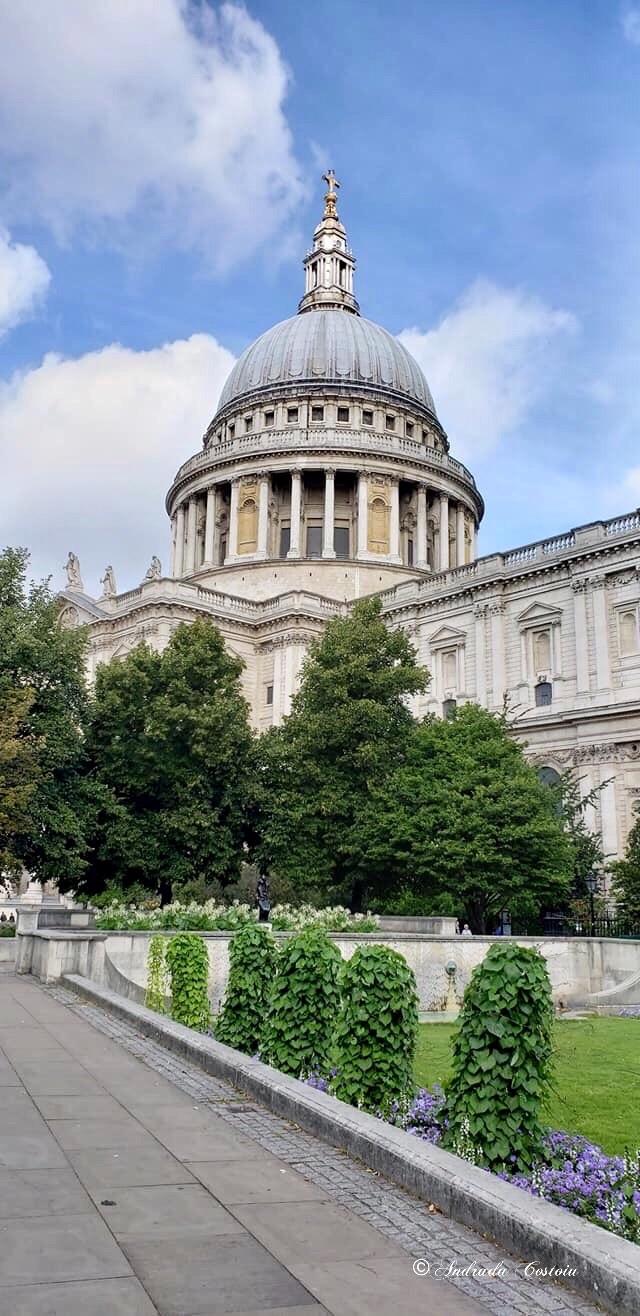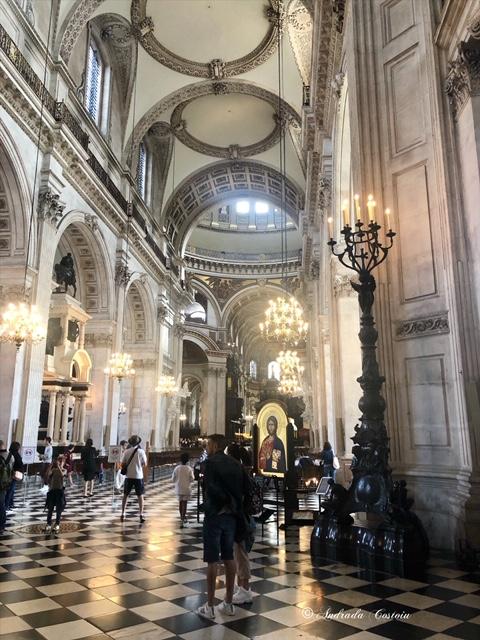
I am reading a book, it’s called “Letters to the lost” by Iona Grey. It’s a beautiful love story, set in London during WW2. As I was reading it, I came across this passage that’s happening in St. Paul’s Cathedral. This sent me back to the time when I was inside it.

I didn’t know about the Whispering Gallery. I wish I knew; I would have climbed up there.
Brief history
St. Paul’s Cathedral is a magic place that goes back in time. I thought this building was the start, but no!! The cathedral building has been destroyed several times and there is so much history behind it! The first on this site was a Roman temple to Diana, but the first Christian cathedral there was dedicated to St. Paul in AD 604. That cathedral burned and its replacement (built 675–685) was destroyed by Viking raiders in 962.
In 1087 a third cathedral erected on the site also burned!
The fourth one, now known as Old St. Paul’s, was constructed in the late 11th century. Its spire stood higher than the dome of the present cathedral. In 1561 the spire was destroyed by lightning (and a resulting fire) and never replaced. Then this building was destroyed in the Great Fire of London (1666), when it was caught in the flames. The lead on the roof melted and poured down on to the street like a river, or so they say. The building collapsed.
The present cathedral, dating from the late 17th century, was designed by Sir Christopher Wren. It was the first Cathedral to be built after the English Reformation in the sixteenth-century, when Henry VIII removed the Church of England from the jurisdiction of the Pope!
It has survived the WW2 Blitz as it is (with repairs) . What was the Blitz? It was the German bombing campaign against the UK, in 1940 and 1941. Not only London, but also provincial UK was bombed. Much of London was lost, including many iconic buildings. St. Paul’s survived probably through a miracle (or maybe because it was protected somehow). Below it’s a picture after the bombings, with St. Paul’s towering over the ruble of London. Since then, this building had become associated with the British resilience.
Who was Christopher Wren and how did he came to build St. Paul’s
After the year of the Great Plague in 1665, The Great Fire of London came! The fire happened in 1666 destroyed many of the city’s public buildings, including 88 of its churches.
Christopher Wren was commissioned to build 51 replacement churches, and that included St Paul’s cathedral. Although Wren was personally responsible for all these, probably not all of them represent his own fully developed design. Only a few are in Wren’s hand, including St. Paul’s.
Wren was many things, not only an architect. He was a scientist and he was one of the founders of the Royal Society (president 1680–82), the oldest scientific society in the world! His work was highly regarded by Isaac Newton and Blaise Pascal.
The architecture
The cathedralis heavily influenced by St. Peter’s Basilica in Rome. The construction of the cathedral took more than 40 years. In 1708, Wren’s son, Christopher Wren Jr, placed the final stone on the lantern, watched by his father below.
I think the most notable feature is the dome. The dome framed by the spires of Wren’s City churches, has dominated London’s skyline for over 300 years. It is still among the highest in the world.

Internally, the church is beautiful ,with impressive arches and naves.


There are famous people buried here.
The first person to be buried in St. Paul’s Cathedralwas its creator. Christopher Wren died in 1723. His tomb is on the south aisle in the east of the crypt.
The crypt of St Paul’s Cathedral is the largest in Europe. The largest memorial on the cathedral floor belongs to the Duke of Wellington. His memorial took longer to build than the whole cathedral!!!
Here you will also find the tombs of Lord Nelson, Florence Nightingale, William Blake, Lawrence of Arabia and many others.
Sunday mass, under the Dome

Picture snapped by my friend while going to the mass
I went to St. Paul’s Cathedral on a Sunday morning, with my friends. We were there for the mass, and it was wonderful.
I don’t like sermons that much, I don’t like when people tell other people what to do or not do. But I like when people learn from each other and I also like when people stand together, united in good thoughts.
Probably that’s why I felt overwhelmed, when the chorus and then everybody started to sing. Under the dome, our voices together sounded powerful, uplifting and hopeful. I think that is the definition of being human.
Together we stand, together we can do great things, each of us doing our own bit.
COPYRIGHT NOTICE
© Andrada Costoiu and a-passion4life.com, 2019 . Unauthorized use and/or duplication of this material without express and written permission from this site’s author and/or owner is strictly prohibited. Excerpts and links may be used, provided that full and clear credit is given to Andrada Costoiu and a-passion4life.com, 2019 with appropriate and specific direction to the original content.

Very interesting and a beautiful structure.
LikeLiked by 1 person
It’s impressive, especially the dome ❤️
LikeLiked by 1 person
Yes!!
LikeLike
BEAUTIFUL ANDRADA! 🙂
Thanks for BEEing LOVE! I’ve nommed you for our BEE LOVE AWARD on IT’S ALL ABOUT LOVE!!! 😊😊 😊
https://passcodelove.com/tag/bee-love-award-from-ybp/
LikeLiked by 1 person
Thank you , I am honored ❤️
LikeLike
I love St Paul’s Cathedral. The architecture is so beautiful, and you’re overwhelmed by a sense of being truly rooted in history.
LikeLiked by 1 person
Gorgeous, and informative writing!
St. Paul’s Cathedral, the sharing of your experience and what it meant to you, and the last three paragraphs…
lovely! ☀️🌷❤️
LikeLiked by 1 person
❤️
LikeLike